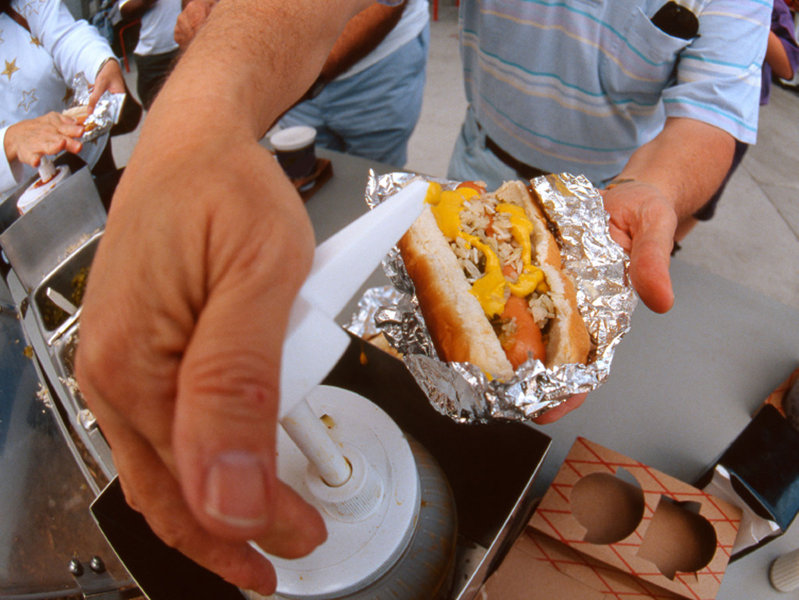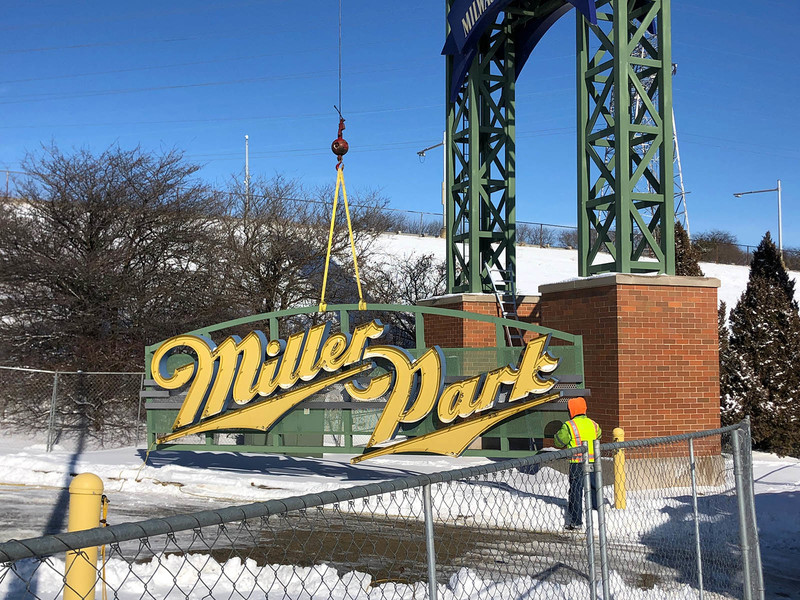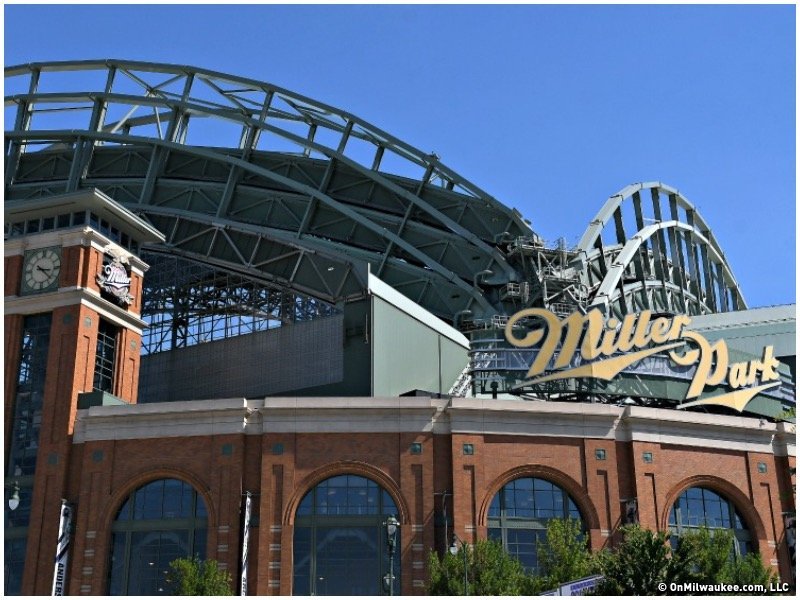Midway through Dining Month here at OnMilwaukee.com, we told you about Mader's, the oldest restaurant in Milwaukee.
That got us thinking ...
What is the busiest restaurant in town?
Some may guess that it's the McDonald's on Hwy. 100 at lunchtime or Serb Hall during a Friday fish fry. Based on our recent readers' survey, some may say that it's Oakland Gyros at bar closing time.
While those are solid suppositions, we think the answer is pretty clear:
Miller Park.
Although the place is only open 81 days a year (barring playoffs, of course), it attracted nearly 2.8 million customers this season and most of them were hungry and thirsty. On an average night, the Sportservice operation at the ballpark, headed by general manager Tom Olson (no relation, -ed.) and operations manager Jon Clope, has about 800 to 900 employees and sells between 12,000 and 14,000 sausages.
We'll save talk about beer sales for when Bar Month rolls around.
We caught up with Olson and Clope shortly after the regular season ended and talked about what it's like to feed nearly three million people in what amounts to 81 four-hour openings.
OnMilwaukee.com: Although the Brewers didn't make the playoffs this season, they did set a franchise attendance record. I'm guessing that meant you guys set some sales records, too?
Tom Olson: We had a great year, no doubt about it. There is definitely a lot of planning that goes into this. It's not just one person. We have a staff of 30 year-round managers that make it happen. We have the .300 Club, the luxury suites, our catering operation, our retail arm, and the club level side. There are really six components that oversee the ballpark.
OnMilwaukee.com: With all the people visiting the ballpark, how do you avoid running out of hot dogs or brats on a given night?
TO: It's one thing to feed 40,000. That's the easy part. The hard part is figuring out the next six days. I always say that it's easier to run a ballpark when it's almost a full house every day. The hard time is when you go from 40,000 people one night to 10,000 people the next and then maybe 20,000 the night after that.
The food isn't the tough part. You can order pallets of beer and brats. Managing the staff is harder. When you tell them to go away, that's harder. This year, we could pretty much say "See you tomorrow," almost every day because we knew that all our people would be back the next day.
T0: Most of our business comes down to hot dogs, nachos, beer, soda pop and pretzels. But, we're always adding some things. We had a baked potato bar this year. We did kettle corn, which was a big hit. Having bigger crowds actually lets you experiment more with new items. This was our first year of having the chorizo. That did pretty well. We've had things in the past like turkey burgers, soy dogs and Gardenburgers. I've had the veggie dog. They're not bad at all. You'll see me put sauce and sauerkraut on it and it blends right in.
JC: About 90 percent of our business is compressed into about three hours. Variety isn't always your friend. Our top 10 items are probably 80 to 85 percent of our business. It's probably like that in every ballpark, every year. The other 50 or 60 items fit into the that 15 percent of your business. It never really wavers. When people come to Miller Park, they're going to have a brat. It's part of the experience. You have to make that available to them.
OMC: How many hot dogs and brats do you sell at a given game?
JC: It's probably between 6,000 and 7,000 brats per night and it's about the same with hot dogs.
OMC: Is there a push to have "healthier" options on the menu? It seems to me that most people treat a night at the ballpark like a mini-vacation from their daily lives and their diets.
JC: The focus groups always say, "We want healthier food." But, it tends to be for "him." He needs it. Salads are minimal business for us. We sold 2,000 soy dogs for the year. They have to be available, but there is not a clamor.
TO: It's easier to find some of that food now than it was in County Stadium. There is no doubt about that.
JC: One thing to remember is that a lot of the people who would come to a ballpark and look for a salad are in the fine dining areas. They aren't part of the general population of the ballpark.
OMC: In terms of fan experience, I consider you guys like umpires. By that, I mean that people only notice when their order is screwed up or they have to wait in a long line. What kind of feedback do you guys get?
TO: I have a few fans that call me once a week. They'll say things like "Tom, the lines weren't too long today." Or, " The brats were pretty good tonight." I get a guy who calls me all the time asking why we don't have dark relish over light relish. They ask why we don't have chopped onions instead of sliced onions. When you're dealing with that many people, you can't keep everybody happy.
OMC: One of the great things about Miller Park is that you can have a sellout crowd here but the park still feels spacious because the concourses are wide. With big crowds, though, come longer lines. What can you do about that?
JC: If you put 40,000 people in here and they all decide to eat at the same time or go to the restroom at the same time, there are going to be some lines. We've found that our peak times are prior to games until about the fifth inning. We encourage fans to come earlier or eat later.
TO: One thing about this business is that it changes from night to night. For the Friday night games, the lines are longer. I don't know if it's because people don't have time to go home and change after work or maybe they take out the tailgating aspect of it. On Saturday, people are able to tailgate and lines are minimal. Each day is different based on the weather and what times the games start.
JC: We always have lines when the Cubs are in town because we get a lot of Chicago people and they don't tailgate.
TO: When the Indians played their games here, the weather was awful and we had 15,000 or 20,000 people. Nobody tailgated. We didn't know how many people were going to come or how many staff to have on for those games. Those were the longest lines I saw in a long time. It was pretty brutal.
When it comes to crowds, all you can do is try to offset it by adding more portable stands. You can't really add more concession stands. You can just put more portable points of sale throughout the ballpark or more vendors in the seats. Of course, when we use more vendors people will call me and say we have too many vendors and they won't bend down. They block people's view of the game.
OMC: What about the in-seat service that is available in the club level. It would seem that having someone take an order with a handheld computer and then go get the food would be pretty streamlined.
TO: That whole concept started back in the ‘90s, I guess. In our ballpark, I don't know if it works that well any more. In basketball, where you've got that two-hour time clock, it works well because people don't like to get out of their seats during the game. With us, it's more relaxed. You've got a lot of time between innings and people don't mind getting out of their seats and walking around.
OMC: The Bradley Center is roughly 20 years old and people are saying that it is out of date. What can you guys do to avoid that at Miller Park?
TO: Every year since we've opened, we've put in money to add points of sale or add a kitchen. We'll never stop. We're going to keep on making this the best place in America. We want the place to be great so that when 20 years comes around, it's not obsolete.
OMC: The design of the concession stand hasn't changed much over the years, has it?
TO: There are a couple ways you can design a stand. You can put the grill right in the front, or you can do a McDonald's-type stand where you have the food behind you and drop it through a slot. We prefer to have things in front so people can see and eat with their eyes.
In most year-round places, those things get remodeled every 10 years. After our first two or three years here, we put in new tile and new cash registers. It's not the same as it was. The menu boards might be the same, but it all gets turned over eventually. Over the course of time, you have to put money back into your product.
TO: I tell everybody I started when I was 16, looking to pay for a car and I'm doing the same thing. I started working here in high school, then I did the college thing, but that didn't work out for me. I probably held most of the jobs in the company. I tell people I went to Sportservice University, because I worked at Busch Stadium in St. Louis, I worked at Comiskey Park in Chicago and at The Ballpark in Arlington. When this building was going to pop, I came back in 1996. I'm from here, so it was exciting. We got to be in on some of the design plans.
JC: I used to work for Kohl's Food Stores. After they were sold for the second time, my wife, who worked with (Sportservice president) Rick Abramson's wife. She said, "Why don't you apply over there?" So, I did. That was 20 years ago. I went to Texas with Tom. I came back four years ago. Wisconsin roots run deep. Everybody comes back.
OMC: Before I let you go, I have a few quick ones for you. Which stand in the park is the busiest?
TO: The two big diners on the wings on the field level are the biggest. Right around Section 125.
OMC: Is it true that people in the "good" seats spend more money?
JC: Probably. But, they offer so many bargains on the terrace level. We have the Badger Mutual promotion, where you get your ticket, a hot dog and a soda.
TO: A lot of times, I'll see people walk in and they'll go down by the field and try to get an autograph or a ball and then they'll get a sandwich and head up to their seats. They like to walk around a little bit and check out what is new. It's part of the experience.
OMC: What's the best part about being in Miller Park as opposed to County Stadium?
TO: The roof. Knowing that you're going to have a game every day. That's the best feature. All those days at County Stadium, we'd sit around and say, "Is it going to rain?" We were a union building, so once employees got on your site, you had to pay for them. We'd always roll the dice and cancel some people. Then the next thing you know the sun would come out and it would be 75 degrees. We don't have to worry about that any more.
OMC: The last question is probably the one you hear more than any other: what's the secret to "Secret Stadium Sauce?"
TO: Back in the ‘70s, when Rick Abramson was around, we ordered ketchup from our vendor. When they went to that palette to send some ketchup up to the concession stands, they discovered that it wasn't ketchup but barbecue sauce.
There was nothing anyone could do. It was either that or nothing. Somebody said "Put it on the grill and warm it up." That's what they did. The next thing you know, Rick is asking, "How about getting it bottled?" It's gone over very well. It's more of a regional thing, a Milwaukee thing. We've got one of our vendors that puts it in stores. If you ask people in Madison, they might not know about it.
OMC: I see the big tubs of it with the other condiments. Do you still have the sauce warm on the grill?
TO: We do. You have to request it, but it's there at most stands. We tell them to make sure they have it.
Host of “The Drew Olson Show,” which airs 1-3 p.m. weekdays on The Big 902. Sidekick on “The Mike Heller Show,” airing weekdays on The Big 920 and a statewide network including stations in Madison, Appleton and Wausau. Co-author of Bill Schroeder’s “If These Walls Could Talk: Milwaukee Brewers” on Triumph Books. Co-host of “Big 12 Sports Saturday,” which airs Saturdays during football season on WISN-12. Former senior editor at OnMilwaukee.com. Former reporter at the Milwaukee Journal Sentinel.







